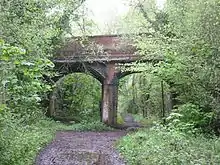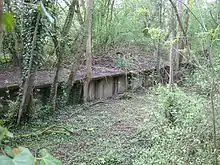Sprat and Winkle Line
The Sprat and Winkle Line was the common name of the Andover to Redbridge railway line which ran between Andover and Redbridge in Hampshire, England. It was built by the Andover and Redbridge Railway, which was incorporated in 1858. In 1863 the uncompleted railway was taken over by the London and South Western Railway (LSWR) who opened the line in 1865 and operated it until 1923 when the LSWR amalgamated with several other railways to create the Southern Railway (SR); in 1948 the SR itself amalgamated with other railways to form British Railways. The line was closed by the Beeching cuts in 1967.
| Sprat & Winkle Line | ||||||||||||||||||||||||||||||||||||||||||||||||||||||||||||||||||||||||||||||||||||||||||||||||||||||||||||||||||||||||||||||||||||||||||||||||||||||||||||||||||||||
|---|---|---|---|---|---|---|---|---|---|---|---|---|---|---|---|---|---|---|---|---|---|---|---|---|---|---|---|---|---|---|---|---|---|---|---|---|---|---|---|---|---|---|---|---|---|---|---|---|---|---|---|---|---|---|---|---|---|---|---|---|---|---|---|---|---|---|---|---|---|---|---|---|---|---|---|---|---|---|---|---|---|---|---|---|---|---|---|---|---|---|---|---|---|---|---|---|---|---|---|---|---|---|---|---|---|---|---|---|---|---|---|---|---|---|---|---|---|---|---|---|---|---|---|---|---|---|---|---|---|---|---|---|---|---|---|---|---|---|---|---|---|---|---|---|---|---|---|---|---|---|---|---|---|---|---|---|---|---|---|---|---|---|---|---|---|---|
| ||||||||||||||||||||||||||||||||||||||||||||||||||||||||||||||||||||||||||||||||||||||||||||||||||||||||||||||||||||||||||||||||||||||||||||||||||||||||||||||||||||||
Passenger services between Andover Junction and Romsey were withdrawn on 7 September 1964. The line between Andover Junction and Town was used for freight until 18 September 1967. The track remained for four years after the line was closed, but much of the route between Chilbolton and Kimbridge is now used by the Test Way long-distance footpath, and is also part of the Sustrans National Cycle Network.
The line between Romsey and Redbridge is still operational although the intermediate station of Nursling closed in 1957.
Possible origins of the name
The name of the line has two main possible origins. The first is that the southern part of the line ran close to the mud flats of the River Test where the winkle may be found but it is unlikely that the sprat is found there.
The second possible origin of the name may be after the seafood that was carried from Southampton to Andover.


Operators
- Andover and Redbridge Railway 1858-1863
- London and South Western Railway 1863-1923
- Southern Railway 1923-1948
- British Railways 1948-1967
History
The Andover and Redbridge Canal defined the original route of the railway line. The canal was fully completed in 1794 and it provided the adequate transport of goods from Southampton to Andover for 63 years.
With the fast expansion of railways around the UK, the canal company decided to convert the canal into a railway to shorten the distance and increase the speed of the route. In 1857 the canal company changed its name to the Andover Canal & Railway Company, and in 1858 the Andover and Redbridge Railway Company obtained an act of parliament to build the line.
The work of converting the canal to a railway started 28 September 1859, with the serving British Prime Minister, the Rt. Hon. Lord Palmerston K.G, ceremonially cutting the first sod. The railway was built on the filled in canal and was opened for traffic on 6 March 1865. Because the line followed the path of the old canal some curves were very sharp and the line was upgraded and realigned when a new course was laid in 1885.
In both the First World War and the Second World War the railway line was invaluable moving troops and war supplies from nearby Salisbury Plain to Southampton on their way to France to fight.
The surrounding area of Redbridge to Andover is rural so the majority of passenger traffic was taking people to the beach during the summer. With the many horse racing stables around the Stockbridge area the railway line was also used to transport racehorses around the country.
With better road networks being built, and in spite of the expansion of Andover, the decision was made to close the line north of Romsey as part of the Beeching cuts of the early 1960s.
References
Further reading
- Leslie Oppitz (2001). Lost Railways of Hampshire. Countryside Books. ISBN 1-85306-689-3
